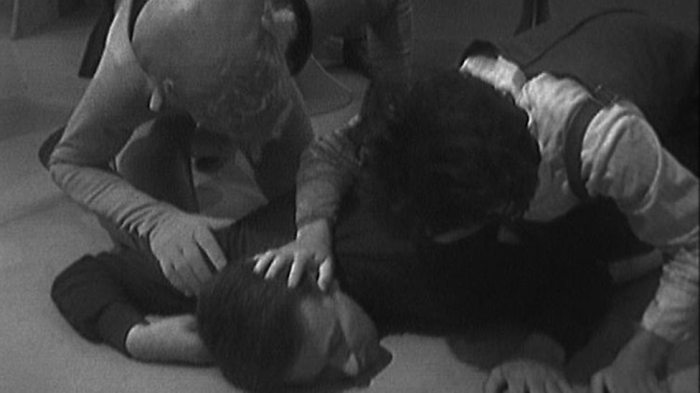Ah, Escape to Danger. I wonder if Terrance Dicks tuned into this episode and mentally filed away the title for later use, as it often turned up as a chapter heading in his Target Doctor Who novelisations. Indeed, just to read those three words transports me back to the 1970’s and that strange world where old Doctor Who was only accessible via the Target book range. But that’s a blog post (or series of posts) for another time.
Back to this Escape to Danger, the Doctor finds himself quizzed by the Animus who is convinced that the Doctor and his friends are the Menoptra. This instantly begs the question, does the Animus not know what the Menoptra look like? Is the Animus blind or might the script implying that all humanoid shapes look the same to it? In another story it may be reasonable to assume that this was just a case of sloppy scripting, but on the bizarre world of Vortis nothing can ever be taken for granted.
Speaking of sloppy scripting, a moment later Vicki stumbles on a control panel which, according to the Doctor, realigns the fluid link and thereby restores the TARDIS’ power. Eh? This is obviously a nod back to The Daleks – although had the fluid link been removed from the ship this would have made more sense (although the image of the Zarbi, with their flapping arms, burrowing under the TARDIS console doesn’t bear thinking about!).
We have to assume that the Animus is so powerful that it can disable a vital function of the ship from a distance. It’s very convenient that Vicki’s blundering reverses this action, but that’s hardly the worst flaw in the story.
The Doctor’s pleased as punch about this and moves to the front of shot to deliver the following short speech. “Trying to destroy my ship, you will achieve nothing. Nothing! I have great secrets in my ship. We could help you.” After more than a few wobbles earlier in the story Hartnell is on much firmer ground here and – with his hands clasped – shows the Doctor at his imperious best. With Vicki and Ian framed in the background it’s a nice, still, moment.
We then see the first flying Menoptra and also witness the Zarbi’s puzzlement as to where they might have gone. They look at the ground rather than up in the sky, but due to their restrictive fibreglass costumes that’s hardly surprising! This episode also has the immortal moment where one of the Zarbi rushes headlong into a camera, making an audible thump (although the noise was sadly toned down a little for the DVD release).
Whilst Ian nips off to look for Barbara, the Doctor and Vicki remain behind at Zarbi HQ. Ian’s fight with a Zarbi has to be seen to be believed – and although brief it was obviously uncomfortable for poor Robert Jewell, stuck within the unforgiving Zarbi costume.
According to contemporary reports, after the scene was completed he was left in considerable pain following the moment when Ian knocks the Zarbi to the floor. Ian’s escape is also the cue for the remaining Zarbi to rush about like headless chickens, beeping all the time. As I’ve said before, a little of this goes a long way, but unfortunately we’re only about halfway through the story.
Ian makes the acquaintance of Vrestin (who refers to him as Heron for the rest of the story). Vrestin is able to fill in the backstory for the audience. “The Zarbi are not an intelligent species, but they were essential to the life pattern here. We lived at peace with them, until they were made militant by the dark power. The Animus. At that time, the Carsinome appeared. Grew like a fungus. We had no weapons. We had not had the need. And by the time we sensed the danger, the Zarbi were too strong.”
Had The Web Planet been a four-parter it might possibly be better regarded as I’m still just about hanging on in there. But things might get rougher over the next few episodes …..





















